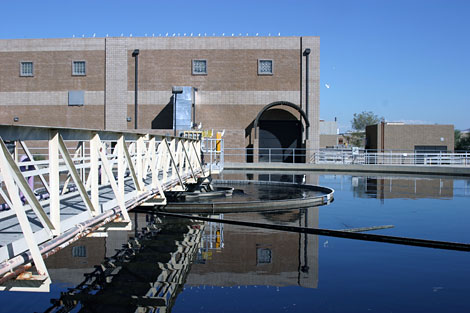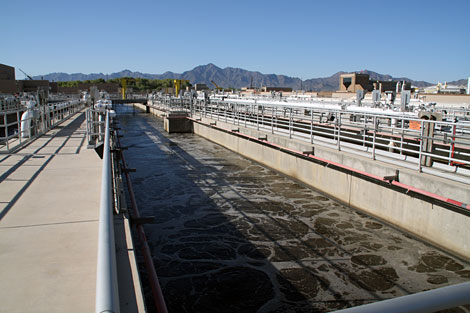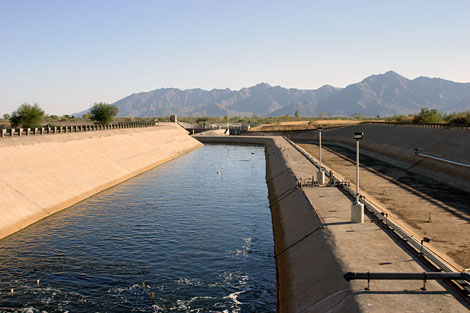

 91st Avenue Wastewater Treatment Plant. Photo courtesy of City of Phoenix Water Services Department.
91st Avenue Wastewater Treatment Plant. Photo courtesy of City of Phoenix Water Services Department.The three main sources of water for the Phoenix metropolitan area are the Central Arizona Project, the Salt River Project, and groundwater. In the west valley, the groundwater table has been dropping at a rate of 1 to 4 feet per year. As the Phoenix metropolitan area moves toward full utilization of Salt River Project and Central Arizona Project surface water supplies for urban use, an additional source - reclaimed water – is becoming increasingly important.
 91st Avenue Wastewater Treatment Plant. Photo courtesy of City of Phoenix Water Services Department.
91st Avenue Wastewater Treatment Plant. Photo courtesy of City of Phoenix Water Services Department.Reclaimed water is needed to meet the need for a sustainable water supply to address growth needs, and as a supplement when surface water supplies are restricted due to drought. Recharging reclaimed water into the aquifer is one way of slowing the decline in the groundwater table.
The Sub-regional Operating Group (SROG) consists of the cities of Phoenix, Scottsdale, Glendale, Mesa, and Tempe. The group has been assessing the possibilities for storing reclaimed water through a linear recharge project in the (usually dry) Agua Fria River. The partnership owns and operates the 91st Avenue Wastewater Treatment Plant that produces approximately 150 million gallons per day of high quality effluent that could be used as the source water for recharging the aquifer.
 91st Avenue Wastewater Treatment Plant. Photo courtesy of City of Phoenix Water Services Department.
91st Avenue Wastewater Treatment Plant. Photo courtesy of City of Phoenix Water Services Department.The benefits for recharging reclaimed water in the western part of the Phoenix metropolitan area include: reducing the rate of decline of the groundwater table, reducing the demand for imported water; and providing a continuous and dependable supplemental source of water.
Phase I, consisting of stakeholder coordination and public information, is complete. Phase I identified the opportunities and constraints associated with the development of a linear recharge project in the Agua Fria River.
Phase II is the initial technical investigation aspect of the project which includes groundwater modeling, preliminary route of pipelines, and sizing of pipelines. This research phase also includes the Environmental Impact Study and Feasibility Study.
Phase III covers development of project designs and Phase IV is the construction phase.
More Information:
http://phoenix.gov/PCD/srog.html
http://www.usbr.gov/budget/2010/LC_10.pdf
http://www.usbr.gov/lc/phoenix/programs/progdescon.html#phoenixmetro
http://phoenix.gov/congress/aguafria.pdf
